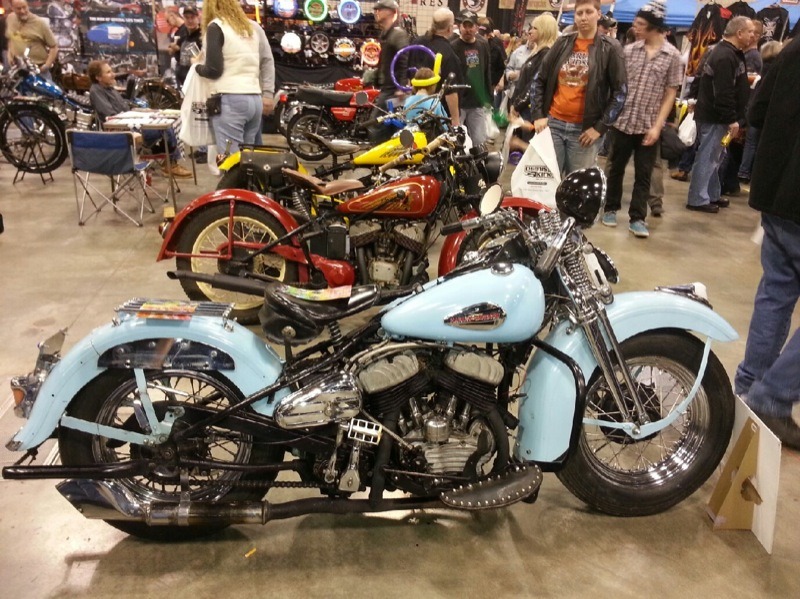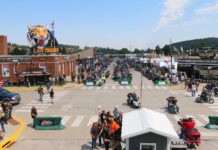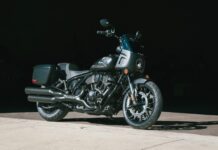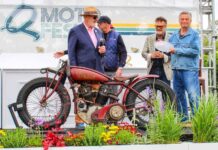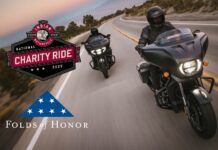ST. PAUL, MINN., MARCH 23-24–The Donnie Smith Bike Show featured many new custom motorcycles, as you’d expect, but also see a lot of restored vintage bikes. The display set up by the Viking Chapter of the Antique Motorcycle Club of America offered the chance to see vintage customs preserved from the first time they were customized 40, 50 and even 60 years ago. Some perfect examples of vintage customs are the “civilianized” rides made by returning G.I.’s after World War II.

When war broke out, the U.S. government contracted both Harley and Indian to produce motorcycles for our military. The most plentiful was Harley-Davidson’s side-valve Flathead WLA, also known as the “45” because of its displacement. Over 90,000 WLAs were made with enough parts to put together around 30,000 more. Although Harley had been making the overhead-valve Knuckleheads since 1936, the military opted for the rock-solid reliability of the low-compression (5:1) side-valve. Anyone with firsthand experience on these machines has amazing stories of the incredible punishment these bikes could take: riding miles with stuck valves, cracked heads, on one piston with a busted frame. It didn’t matter—the WLA could take it.
So it was natural that the WLA proved popular with returning veterans and civilians alike, who were looking for a dependable and easy-to-maintain machine. And did I mention inexpensive? With tons of surplus spare parts, it was easy to find anything you needed to build and run a WLA. For years after the war, you could still order a WLA in a crate from the back pages of a Popular Mechanics magazine.
Of course, hardly anyone kept their WLA military-stock. Paul St. John’s WLA on display at the Donnie Smith show was a perfect example of the types of customizing that were popular in the post-war period. The OD green paint made perfect primer, so St. John’s ’42 WLA has sky blue paint layered right on top. And just like guys have done for as long as they’ve owned motorcycles, his bike sports plenty of chrome: the springer fork, toolbox, muffler tips, luggage rack and rims. Even today St. John’s WLA lives up to its rugged roots. He puts thousands of miles on his bike, riding it to work nearly year-round and also to Sturgis many times!

Sitting next to St. John’s bike at the show was Indian’s answer to the WLA: the 741. Tom McLaughlin’s “civilianized” machine demonstrates the alternative route tried by Springfield as they vied with Milwaukee for military contracts. Instead of going big, Indian went light and nimble with their 741 by taking the amazingly agile Scout (the bike preferred for decades by Wall of Death riders looking for a perfectly balanced machine) and powering it with a lighter 500cc engine, down from the typical 745cc previously used in Scouts. Unfortunately for Indian, going light didn’t work out so well with the U.S. military and many of the 42,000 741s produced by Indian were sold overseas to our allies. Still, there were plenty of surplus machines after the war to feed the needs of both returning G.I.’s and civilians who couldn’t purchase a motorcycle during the war when only “essential use” purchases were permitted.
Checking out McLaughlin’s 741 Indian, you could easily see that the machine was stripped down compared to the ornate beauties Indian was famous for before the war. Its fenders and chain guard were minimal—nearly “bobbed”—and its lights and speedo kept small. Although from a distance, with its OD paint replaced by a more typical Indian red and a hand-painted Indian logo on the tank, McLaughlin’s bike looks almost stock—a major departure from a machine made for war.
The “civilianized” motorcycles on display in the Viking AMCA booth were a big hit with the crowd, but nothing compared to the attention drawn by the twin rocket-powered motorcycle built by Ky Michaelson. Yep, that’s right—two 1,500-pound thrust-rocket motors mounted inside a 1977 Harley-Davidson Sportster. Michaelson is famous around the world for his long career as a drag racer, Hollywood stuntman and builder of some of the fastest machines ever to hit a drag strip or the salt flats. The highlight of his rocket-powered career was his role leading the team that won the original “X-Prize” in 2004 as the very first civilian rocket launched into outer space. But back in ’77, Michaelson was building drag cars and bikes, breaking records and pulling off crazy stunts. In fact, ’77 was the year that his rocket-powered drag car, piloted by the legendary racer Kitty O’Neil, shattered the record for the quarter-mile, running it in 3.22 seconds at 412 mph!

Michaelson was contacted by a daredevil named Rick Rojatt to build him a bike to break Evel Knievel’s record of jumping 13 buses. Rojatt went by the name “The Human Fly” and took his persona seriously, never appearing outside of full costume and mask. The craziest thing about Rojatt’s plan was that he wanted to do it indoors during the intermission of a rock concert at Montreal’s Olympic Stadium. Michaelson was horrified by the constraints imposed on both how fast he could get the bike going on approach and how quickly he’d have to stop on the other side of the jump before hitting the wall. Michaelson calculated that he’d need to be going at least 80 mph when he left the ramp and accelerate further once in the air. When the bike was finished, Michaelson estimated that it punched out 6,000 hp—enough to run the quarter-mile at 300 mph!
On the day of the jump, Michaelson arrived at the stadium to find that the construction crew had not followed his blueprints exactly. Instead they had built the launch ramp too steep and the receiving ramp higher than the tops of the buses! They did what they could, but still were dismayed by the thought of Rojatt attempting the stunt without a single practice run. But luck shone down on The Human Fly that day as he successfully made the jump and broke Knievel’s record—only breaking one ankle!
After that fateful day, the trail went cold on the bike and Michaelson lost track of it. Twenty-three years later, he found a “Rocket Bike” listed for sale in the Florida Trading Times. He couldn’t believe his eyes so he called the owner and verified that it was indeed the Rocket Bike he had built for the Human Fly. Today the bike sits in Michaelson’s living room and made its first appearance at the Donnie Smith show this year.
With Michaelson’s Rocket Bike in the Viking Chapter AMCA display, a crowd constantly gathered around the old bikes. If you’re into checking out the old bikes, too, don’t miss the largest display of vintage motorcycles in the Midwest hosted by the Viking AMCA at the Minnesota State Fairgrounds June 14 and 15. Visit www.vikingmc.org for more info.


